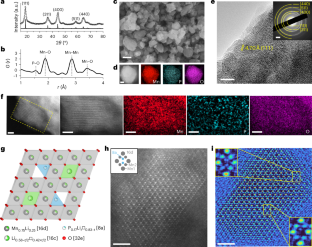MIT News August 23, 2024
Co- and Ni-free disordered rock salt cathodes utilize oxygen redox to increase the energy density of lithium-ion batteries, but it is challenging to achieve good cycle life at high voltages >4.5 V. An international team of researchers (USA – MIT, Pennsylvania State University, Argonne National Laboratory, Lawrence Berkeley National Laboratory, Brookhaven National Laboratory, South Korea, Canada, China, Taiwan) found a family of Li-excess Mn-rich cathodes that integrates rock salt- and polyanion-type structures. Following design rules for cation filling and ordering, they demonstrated the bulk incorporation of polyanion groups into the rock salt lattice. This integration bridged the two primary families of lithium-ion battery cathodes—layered/spinel and phosphate oxides—dramatically enhanced the cycling stability of disordered rock salt cathodes with 4.8 V upper cut-off voltage. The cathode exhibited high gravimetric energy densities over 100 cycles. According to the researchers their study opens a broad compositional space for developing battery cathodes using earth-abundant elements such as Mn and Fe… read more. TECHNICAL ARTICLE

Structural characterization of Li1.67Mn1.5P0.17O4. Credit: Nature Energy, 23 August 2024